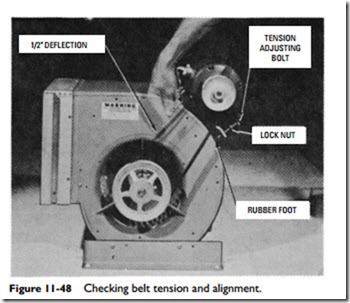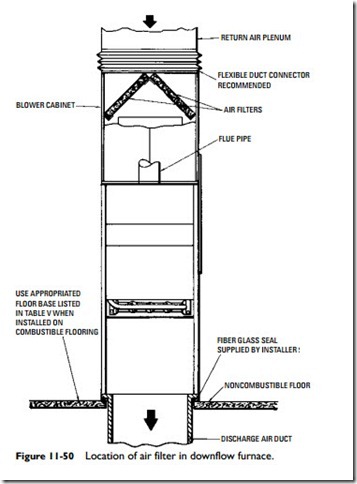Direct-Drive Blower Adjustment
The blower (fan) of a direct-drive unit is operated by a drive shaft
connected to the motor. Three common direct-drive motors used with blowers are:
1. Two-speed, direct-drive shaded pole motors
2. Three-speed, direct-drive PSC motors
3. Four-speed, direct-drive PSC motors
These blower motors are shipped from the factory set for low- speed heating operation. If a higher operating speed is desired, the red blower motor wire must be moved from the low-speed red terminal to a higher speed terminal.
Belt-Drive Blower Adjustment
Air-temperature rise can be decreased by increasing the blower speed.
A belt-drive unit can be adjusted for a higher speed as follows:
1. Loosen the set screw in the movable outer flange of the motor pulley.
2. Reduce the distance between the fixed flange and the movable flange of the pulley.
3. Tighten the set screw.
The procedure for decreasing the blower speed (and thereby increasing the air-temperature rise) is similar except that in Step 2 above, the distance between the fixed flange and the movable flange of the pulley are increased.
The motor and blower pulley should be aligned to minimize belt wear. The belt should be parallel to the blower scroll. Adjustments can be made by moving the motor or adjusting the pulley on the shaft.
Correct belt tension is also important. Belt slippage occurs when there is too little tension. Too much tension will cause motor over- load and bearing wear. Correct belt tension will usually be indicated
by the amount of depression in the belt midway between the blower and motor pulleys. Usually this will be a 1-in depression at the center of the belt, but it may vary among different furnace manufacturers. Check the furnace manufacturer’s specifications and service manual for the preferred amount of belt tension (Figure 11-48).
Air Filters
A forced-warm-air, gas-fired furnace is supplied with either a dis- posable air filter or a permanent (washable) one. The type of filter will be indicated on a label attached to the filter. Never use a filter with a gravity warm-air furnace, because it will obstruct the airflow.
Proper maintenance of the air filter is very important to the operating efficiency of the furnace. A dirty, clogged air filter reduces the airflow through the furnace and causes air temperatures inside the unit to rise. This increase in air temperature results in a reduced life for the heat exchanger and a lower operating efficiency for the furnace.
If a disposable air filter is used, it should be inspected on a monthly basis. If it is dirty, it should be replaced. This is usually done at the beginning and middle of the heating season. The same
schedule should be followed during the summer months when air conditioning is used.
If a permanent filter is provided, it must be removed and cleaned from time to time. Cleaning the filter involves the following procedure:
1. Shake it to remove dust and dirt particles.
2. Vacuum it.
3. Wash it in a solution of soap or detergent and water.
4. Allow time for it to dry.
5. Replace it in the furnace.
Read the label on the filter for any special instructions that may apply to cleaning it. The location of filters in upflow and downflow furnaces is shown in Figures 11-49 and 11-50. Note that, in each case, the air filter is placed directly in the path of the air entering the furnace.
A filter should be installed in the return plenum or duct when air conditioning is added to the system. Because air conditioning normally requires a greater volume of air than heating, the filter should be sized for air conditioning rather than heating.
Access to internally installed filters is generally provided through a service panel on the furnace. Instructions for cleaning or replacing the filters should be placed on the service panel. It would be a good idea to include the dimensions of the replacement filter(s) in the information.
An adequate filter should provide at least 50 in2 of area per cfm of air circulated. For an air velocity of 1000 cfm, this would mean a filler area of 400 in2. Filters sized on 50 in2 for each 100 cfm meet the requirements of air conditioning—a greater volume of air than heating.
Never use a smaller-size filter than the one required in the specifications. To do so would create excessive pressure drop at the filter, which would reduce the operating efficiency of the furnace.
Additional information about air filters can be found in Chapter 13, “Air Cleaners and Filters” in Volume 3.
Air Conditioning
If you intend to install air conditioning equipment at some future date, the duct sizing should include an allowance for it. Air conditioning involves a greater volume of air than heating. Quite often,
the blowers and motors of the furnace will be sized for the addition of cooling with matching evaporator coil and condensing unit. Check the specifications to be sure.
All ductwork located in unconditioned areas (for example, attics, crawl spaces) downstream from the furnace should be insulated. A
furnace used in conjunction with a cooling unit should be installed in parallel or on the upstream side of the evaporator coil to avoid condensation on the heating element. In a parallel installation, dampers or comparable means should be provided to prevent chilled air from entering the furnace.


